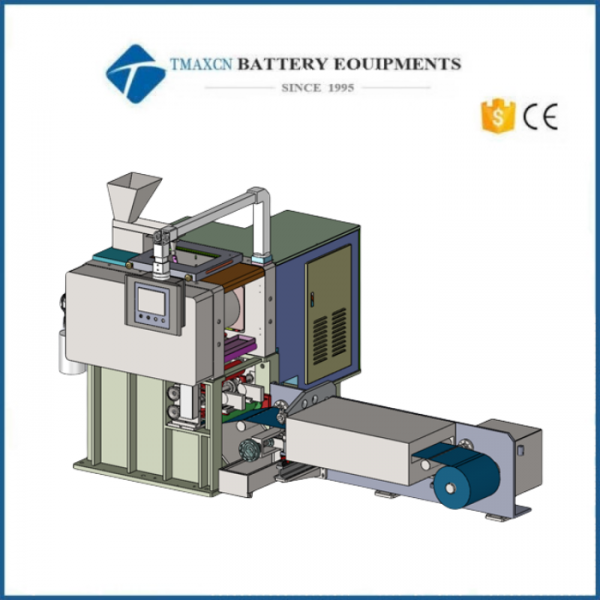Linea di macchine per la produzione di celle cilindriche automatiche
fabbricazione e attrezzatura del laboratorio della batteria agli ioni di litio 18650
diagramma di flusso delle celle a bottone agli ioni di litio ed elenco delle macchine
fabbricazione e attrezzatura del laboratorio della batteria del sacchetto dello Li-ione
- Posta elettronica : David@tmaxcn.com
- Posta elettronica : Davidtmaxcn@gmail.com
- : No. 39, Xinchang Road, Xinyang, Haicang Dist., Xiamen, Fujian, China (Mainland)
Xiamen Tmax Battery Equipments Limited was set up as a manufacturer in 1995, dealing with lithium battery equipments, technology, etc. We have total manufacturing facilities of around 200000 square foot and more than 230 staff. Owning a group of experie-nced engineers and staffs, we can bring you not only reliable products and technology, but also excellent services and real value you will expect and enjoy.
Dry Electrode System: A Breakthrough in Energy Storage Technology
The dry electrode system represents a transformative approach to producing electrodes for energy storage devices, such as lithiumion batteries, solidstate batteries, and supercapacitors. Unlike traditional wetcoating methods that rely on solventbased slurries, the dry electrode system uses dry mixing and compression techniques to create highperformance electrodes without solvents. This innovation simplifies manufacturing processes, reduces environmental impact, and enhances the mechanical properties of electrodes.
In this article, we will explore the structure, functionality, advantages, challenges, and innovations associated with the dry electrode system.
●What Is a Dry Electrode System?
A dry electrode system is a manufacturing process and equipment setup designed to produce electrodes using dry materials. Instead of mixing active materials, binders, and conductive additives into a liquid slurry, the dry electrode system combines these components in powder form and compresses them onto a current collector foil (e.g., aluminum or copper). This solventfree approach eliminates the need for drying ovens and solvent recovery systems, significantly reducing energy consumption and waste.
The primary goal of the dry electrode system is to enable sustainable, efficient, and highperformance electrode fabrication for advanced energy storage applications.
●Key Components of a Dry Electrode System
A typical dry electrode system consists of the following key components:
1. Dry Mixing Module
Combines active materials (e.g., graphite, silicon, metal oxides), binders (e.g., polytetrafluoroethylene [PTFE] or alternatives), and conductive additives (e.g., carbon black) into a homogeneous powder mixture.
Ensures uniform particle distribution and optimal adhesion properties.
2. Calendering Module
Compresses the dry powder mixture onto a current collector foil under high pressure to form a dense, adherent electrode layer.
Adjusts the thickness of the electrode layer with high precision.
3. Cutting and Tab Welding Module
Cuts the coated current collector into predefined dimensions using laser cutting or mechanical dies.
Attaches current collector tabs via resistance welding, ultrasonic welding, or laser welding.
4. Quality Inspection Module
Detects defects such as uneven coatings, cracks, or misaligned tabs using vision systems.
Measures the uniformity of the electrode layer with thickness gauges.
Verifies the bond strength between the electrode layer and the current collector with adhesion testers.
5. Packaging Module
Prepares finished electrodes for integration into battery or supercapacitor cells.
●Processes Performed by a Dry Electrode System
The dry electrode system performs the following key processes:
1. Dry Mixing: Combines active materials, binders, and conductive additives into a homogeneous powder mixture.
2. Calendering: Compresses the powder mixture onto a current collector foil to form a dense electrode layer.
3. Cutting and Tab Welding: Shapes the electrode and attaches current collector tabs.
4. Inspection: Verifies the quality and consistency of the electrodes.
5. Packaging: Prepares the electrodes for further assembly into cells.
●Advantages of a Dry Electrode System
1. Environmental Benefits:
Eliminates the use of toxic solvents, reducing emissions and waste.
Reduces energy consumption during drying and solvent recovery processes.
2. Cost Savings:
Simplifies the production process by eliminating solventrelated steps.
Reduces material waste due to precise handling and realtime quality checks.
3. Improved Performance:
Enhances the mechanical stability of electrodes, leading to better cycle life and performance.
Allows for higher loading of active materials, increasing energy density.
4. Scalability:
Enables faster production rates compared to traditional wetcoating methods.
Can be easily scaled up for mass production.
5. Flexibility:
Compatible with a wide range of materials, including nextgeneration chemistries like silicon anodes and solidstate electrolytes.
6. Safety:
Minimizes exposure to hazardous chemicals, improving workplace safety.
●Challenges in a Dry Electrode System
Despite its advantages, the dry electrode system faces certain challenges:
1. Material Handling:
Handling dry powders uniformly without introducing air pockets or inconsistencies can be challenging.
Ensuring proper adhesion between the electrode layer and the current collector requires precise control.
2. Binder Selection:
Developing binders that work effectively in dry conditions while maintaining adhesion and flexibility is complex.
3. High Initial Costs:
Advanced machinery and specialized components come with significant upfront investment.
4. Adaptation to New Technologies:
Rapid advancements in electrode materials and cell designs require frequent upgrades to keep equipment uptodate.
5. Process Optimization:
Achieving consistent results across largescale production requires finetuning of parameters such as pressure, temperature, and speed.
●Innovations in Dry Electrode Systems
To address these challenges and enhance productivity, manufacturers are incorporating cuttingedge technologies:
1. Advanced Mixing Techniques:
Highshear mixers and planetary mixers ensure uniform particle distribution.
2. AI and Machine Learning:
Predictive analytics optimize machine performance, detect anomalies, and improve yield rates.
3. Modular Design:
Flexible systems allow for easy reconfiguration to test new materials and chemistries.
4. Sustainability Features:
Ecofriendly practices minimize waste and energy consumption during the fabrication process.
5. Integration with SolidState Technologies:
Future systems will be designed to handle solidstate electrolytes, enabling safer and more efficient nextgeneration batteries.
6. Collaborative Robotics:
Humanmachine collaboration enhances flexibility and adaptability in production processes.
●Applications of Dry Electrode Systems
Dry electrode systems are used in various industries, including:
1. Battery Production:
Produces electrodes for lithiumion batteries, solidstate batteries, and other advanced battery chemistries.
2. Supercapacitors:
Creates highperformance electrodes for energy storage applications in consumer electronics, automotive systems, and renewable energy.
3. Automotive Industry:
Manufactures electrodes for electric vehicle (EV) batteries, focusing on improving energy density and reducing costs.
4. Renewable Energy:
Develops durable electrodes for gridscale energy storage systems.
5. Consumer Electronics:
Produces compact and efficient electrodes for smartphones, wearables, and portable devices.
●The Future of Dry Electrode Systems
As the demand for sustainable and highperformance energy storage solutions grows, dry electrode systems will continue to evolve. Key trends shaping the future include:
1. Increased Automation:
Fully autonomous systems will further boost production speeds and reduce costs.
2. Customization Options:
Modular designs will enable manufacturers to tailor systems for specific materials and cell designs.
3. Focus on Sustainability:
Ecofriendly practices and recycling capabilities will become integral parts of future systems.
4. Integration with Emerging Technologies:
Solidstate batteries, flexible electronics, and autonomous systems will drive new innovations in system design.
5. Smart Manufacturing:
IoTenabled systems will leverage big data and AI to optimize production, reduce waste, and enhance efficiency.
●Conclusion
The dry electrode system is revolutionizing the energy storage industry by enabling sustainable, efficient, and highperformance electrode fabrication. Its ability to eliminate solvents, reduce waste, and improve mechanical properties makes it a gamechanger for battery and supercapacitor manufacturing.
What excites you most about the role of dry electrode systems in driving innovation and sustainability in the energy storage sector? Share your thoughts below! Together, let’s explore how this technology can shape the future of energy storage.
 ru
ru English
English











 Iris@tmaxcn.com
Iris@tmaxcn.com David@tmaxcn.com
David@tmaxcn.com +86 13174506016
+86 13174506016
